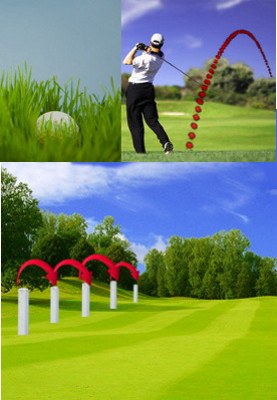
Golf Rule 15, Substituted Ball; Wrong Ball – Simplified Version
15-1. Players must finish each hole with the same ball they use to tee off, unless the ball is lost, out of bounds, or replaced with a substitute ball.
15-2. During a hole, a player can replace his ball with a substitute if a rule allows it via drop, or if the ball is deemed unfit for play per rule 5-3. If the player replaces his ball in a way that breaks the rules, he finishes the hole with that ball but loses the hole in match play or takes a two-stroke penalty in stroke play.
Exception: If a player hits a ball from a wrong place, there’s no added penalty for improperly replacing his ball.
15-3. In match play, a player hitting a wrong ball (i.e., any ball that isn’t considered his ball in play) loses the hole.
In stroke play, hitting a wrong ball is a two-stroke penalty. After hitting the wrong ball (which doesn’t count), the player must finish the hole with his correct ball. If he tees off on the next hole, or holes out on the last hole, without correcting the mistake, he’s disqualified.
Exception: There is no penalty for hitting a wrong ball that’s moving in a water hazard, and the stroke made doesn’t count. The player must then hit his actual ball or drop according to the rules.
15-1. General
A player must hole out with the ball played from the teeing ground, unless the ball is lost or out of bounds or the player substitutes another ball, whether or not substitution is permitted (see Rule 15-2). If a player plays a wrong ball, see Rule 15-3.
15-2. Substituted Ball
A player may substitute a ball when proceeding under a Rule that permits the player to play, drop or place another ball in completing the play of a hole. The substituted ball becomes the ball in play.
If a player substitutes a ball when not permitted to do so under the Rules, that substituted ball is not a wrong ball; it becomes the ball in play. If the mistake is not corrected as provided in Rule 20-6 and the player makes a stroke at a wrongly substituted ball, he loses the hole in match play or incurs a penalty of two strokes in stroke play under the applicable Rule and, in stroke play, must play out the hole with the substituted ball.
 Exception: If a player incurs a penalty for making a stroke from a wrong place, there is no additional penalty for substituting a ball when not permitted.
Exception: If a player incurs a penalty for making a stroke from a wrong place, there is no additional penalty for substituting a ball when not permitted.(Playing from wrong place – see Rule 20-7)
15-3. Wrong Ball
a. Match Play
If a player makes a stroke at a wrong ball, he loses the hole.
If the wrong ball belongs to another player, its owner must place a ball on the spot from which the wrong ball was first played.
If the player and opponent exchange balls during the play of a hole, the first to make a stroke at a wrong ball loses the hole; when this cannot be determined, the hole must be played out with the balls exchanged.
 Exception: There is no penalty if a player makes a stroke at a wrong ball that is moving in water in a water hazard. Any strokes made at a wrong ball moving in water in a water hazard do not count in the player’s score. The player must correct his mistake by playing the correct ball or by proceeding under the Rules.
Exception: There is no penalty if a player makes a stroke at a wrong ball that is moving in water in a water hazard. Any strokes made at a wrong ball moving in water in a water hazard do not count in the player’s score. The player must correct his mistake by playing the correct ball or by proceeding under the Rules.(Placing and Replacing – see Rule 20-3)
b. Stroke Play
If a competitor makes a stroke or strokes at a wrong ball, he incurs a penalty of two strokes.
The competitor must correct his mistake by playing the correct ball or by proceeding under the Rules. If he fails to correct his mistake before making a stroke on the next teeing ground or, in the case of the last hole of the round, fails to declare his intention to correct his mistake before leaving the putting green, he is disqualified.
Strokes made by a competitor with a wrong ball do not count in his score. If the wrong ball belongs to another competitor, its owner must place a ball on the spot from which the wrong ball was first played.
 Exception: There is no penalty if a competitor makes a stroke at a wrong ball that is moving in water in a water hazard. Any strokes made at a wrong ball moving in water in a water hazard do not count in the competitor’s score.
Exception: There is no penalty if a competitor makes a stroke at a wrong ball that is moving in water in a water hazard. Any strokes made at a wrong ball moving in water in a water hazard do not count in the competitor’s score.(Placing and Replacing – see Rule 20-3)






